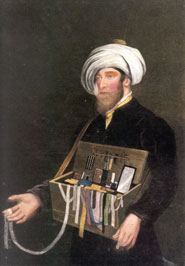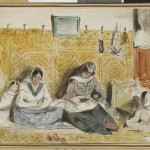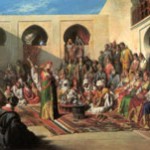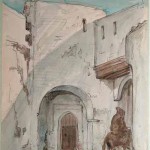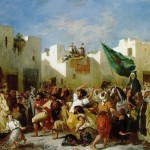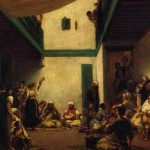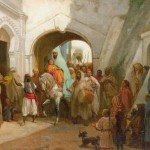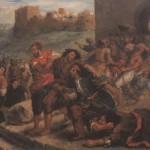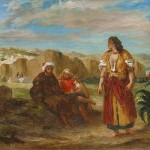A Brief History of the Jews
Marc Eliany* (c) All Rights Reserved
Part 1: The Israelites
The Hebrews
The history of the Jews begins with Abraham the patriarch leaving Ur (at the time of Ur Nammu, the king and legislator, about 2000 BCE) to Haran, Canaan, Egypt, finally settling in Hebron, where he purchased a tract of land used as a burial place for him and his family (the Cave of Machpelah).
Hebron was a shrine for the descendents of Abraham for many years. King David was anointed there. But when Jerusalem fell, Edom, Greece, Rome, Arabs, Franks and Mamluks settled it, each leaving behind its mark, especially Heron the Great (a wall enclosure) and Saladin (a pulpit).
Abraham did not take Hebron by force. He acquired land rights for a price and contractual agreement with Ephron the Hittite. Abraham distinguished himself from his neighbors through association with an omnipotent God, mythical figures committed to do right on earth (i.e., Adam, Shem the priest and Noah, the righteous, who built an ark to save humanity from extinction) as well as a conception of right and wrong. Abraham stood out as a just man, concerned for his fellow men, like his ancestors. He was shy of war and hospitable to strangers but put in a historical context, Abraham was a leader of a cultivated tribe, one of many Habiru (Hebrew) tribes that migrated for economical reasons from Mesopotamia to the Mediterranean, to earn a living as merchants or to work in the services of local kings. He was versed with contract making and his relation to God was contractual in nature: an exchange of land, fertility (offspring) and blessed universality (in thy seeds shall all the nations be blessed) for loyalty. Disobedience implies a loss of privileges even if God’s promise stands forever.
Jacob Israel
By the time of Jacob, Abraham’s grandson, the Hebrew tribes acquired a sense of belonging to the land of Canaan and their identity crystallized around a common ancestry, with Jacob at its core. Jacob was the man who did right with God to re-name himself and his people – Israel. Around this time, Shechem (near ancient Vespasian Neapolis, 72 CE, nowadays Nablus) was already a capital city of the Hebrews and although some of the tribes lived in Egypt and wandered around Canaan, they clearly identified Canaan as an ancestral land they could return to, that is the Land of Israel.
Joseph and Moses
Hebrews lived in Egypt since the days of Abraham. They were foreign workers who occasionally reached leadership positions. One of the most distinguished Hebrews to achieve prominence in Egypt was Joseph, an able administrator and visionary, a model for generations of Jews in foreign lands thereafter. But alas, the fate of foreign workers has always been precarious and during the reign of Rameses II (1304-1237 BCE), oppression drove the Hebrews to emigration and even to revolt during the reign of Merneptah (1220 BCE). Moses, a spiritual man, lawmaker and judge, led the Exodus that marked the memory of the Hebrew tribes to such an extent that it transformed them into the nation of Israel. Moses did not only change the fate of the Israelites, he transformed the ancient world too, for according to ancient observers, he re-invented the concept of law, making it entirely novel and something for subsequent civilizations to adopt.
Moses’ Code regulates a definition of God as an infinite concept associated with ethical principles, equality before the law, the sanctity of human life and the human body (man created in the image of God), rest (Sabbath and holidays), sexual behavior (ban of irregular forms of sex, i.e., bestiality as well as consanguinity), hygiene (i.e., leprosy and circumcision) and dietary laws (consumption of ruminants and prohibition of animals harboring parasitic organisms).
Joshua, Judges, Kings and Prophets
Joshua took over the leadership from Moses and led the conquest of Canaan through reinforcement of existing Israelite settlements (i.e., Shechem), alliances and negotiated surrenders (i.e., Gibeon) but also forceful invasion (i.e., Kadesh, Jericho, Hazor). A full-scale conquest may have been delayed due to entrenched equality, tribal divisiveness and resistance to central authority. After Joshua’s death, the conquest of Canaan was led by judges through ad hoc military tribal coalitions and was consolidated only when all tribes united in one kingdom (1200-925 BCE).
Leadership at this time was set in a democratic theocracy and was earned through blessed merit and hard work (i.e., Ehud, Deborah, Jephthah, Samson, Saul, David,1005-966 BCE). Prophets, who emphasized ethical conduct rather than rituals and temporal power, admonished priests, military and political leaders, who, worked side-by-side during this period. The emphasis on ethical conduct created perennial tensions between heavenly and temporal powers, which remain till our days.
King David brought all the Israelites under central rule, making Jerusalem a national capital but tribal resistance persisted (i.e., we have no part in David… Every man to his tent, O Israel). David solidified Israel’s economy by controlling regional trade routes and contained the Philistines and Canaanites as well as established authority over other neighbors (i.e., Ammon, Edom, Moab, Aram). King Solomon consolidated his father’s gains but proved less sensitive to tribal pride and religious ethics. Solomon taxed the Israelites heavily to build a strong army to maintain Israel’s unity and regional status. He also intertwined diplomacy and trade to enrich Israel’s economy and to finance ambitious building projects (i.e., temples and palaces) but in the process, he sacrificed the old ethics that held the Israelites together. Solomon’s kingdom broke into Israel and Judea after his death (925 BCE), exposing both to dangers as empires rose (Babylon and Assyria).
Politics among the Israelites have been dominated by righteousness since the days of Abraham. Moses inscribed righteousness into law, prophets watched over its application, rebuking kings when deviating from it.
Israel benefited from the separation from Judea. The economy improved due to an alliance with sea trading Sidon, under Omri, Ahab and Jehu but the gap between rich and poor and paganism increased and prophets’ appeals for redress did not help (i.e., Elijah, Elisha, Amos, Hosea). By 722 BCE, internal tensions and external Assyrian oppression brought upon Israel destruction, deportation and assimilation (i.e., the lost tribes of Israel).
Judaism survived in Judea for a while longer. Jerusalem reformed it-self (Jehoiada, Hezekiah, Josiah) and re-kindled hopes that repentance can re-establish social justice and even bring universal peace on earth (Isaiah, Jeremiah, Baruch). Babylon rose to master the Middle East and capture Jerusalem (597 BCE). But destruction no longer mattered because Judaism was reformed to thrive in adversity, breaking through national barriers to spread a universal message to humanity.
Part 2: Judaism
After the destruction of Jerusalem, the Jews dispersed in the old world (597 BCE). Without state or government, law and history defined Jewish identity. Circumcision, rules of cleanliness, the Sabbath and the holidays (Passover, Pentecost, Tabernacle, New Year and the Day of Atonement) defined their rituals. But Judaism was more than rituals and when scribes recorded its essence in legal terms, people learned it and adhered to it of their own free will.
With the rise of the Persian Empire, Babylonian Jews were given the opportunity to return to their homeland to rebuild Jerusalem but most stayed behind in the Diaspora. Life in the Persian Empire was comfortable; yet, some returned to Jerusalem (Shenazar, Zerubabel, Ezra and Nehemiah) to rebuild it (538-445 BCE), in spite of forceful objections by the local population (local inhabitants mixed with deportees brought in by Assyrians, i.e., Samaritans).
Ezra and Nehemiah re-edited the Mosaic Law and although most Jews remained in the Diaspora, scribal and educational practices preserved Judaism. The Jews were the first to create a substantive record of law, legends and history and attribute it to a divine power, although its main actors are human beings (albeit born the image of God). The Pentateuch or the Torah was canonized first around 622 BCE. The remaining books of the Bible were added gradually and sealed around 300 BCE. But there are also well known exclusions (Wisdom of Solomon, the Wisdom of Ben Sirah, the books of Daniel, Judith, Tobit, Baruch, the Maccabees and Josephus as well as the Dead Sea Scrolls). Subsequently, much has been written to explain, elaborate and adapt previous records to contemporary times but transcending them all, is the question of moral order to which human beings are to abide.
Alexander of Macedon cracked the Persian Empire to expose the Jews to Greek rule and culture (332-200 BCE). Purist, as usual, retreated to the desert to re-group before purging Judaism from Greek culture, but most Jews, especially in the Diaspora, adopted Hellenism and the affluence it brought. Jewish elites were quite willing to pay their dues and taxes to Greek rulers as long as they were given the freedom to practice their own religion. Some even attempted to reform Judaism to fit the Greek era (i.e., Jason 175 BCE and Menelaus 167 BCE). But when Antiochus, the Greek ruler and his reformist allies attempted to speed up the process of Hellenization, they met stiff resistance. Traditionalists (the Hassidim) led by a priesthood family (the Hasmoneans) assaulted reformists and launched a guerrilla war on the Greek occupiers (166 BCE), drove them out of Jerusalem (Hannukah, 164 BCE) and signed a treaty with Rome (161 BCE). By 152 BCE, when the Greeks realized they could not crush the revolt, they recognized Jonathan the Maccabee as high priest, conceding independence to Judea thereafter (142 BCE).
The Hasmoneans joined priesthood and government to rule 115 years. Their success was timed by the decline of the Greek Empire and the rise of Rome and their failure was characterized by a strict interpretation of the Mosaic Law (a Sadducean approach) and by their attempt to impose it on Jews and conquered neighbors alike. For Herod the Great (63-4 BCE), the son of an Idumean convert and powerful minister who married into the Hasmoneans, turned Judea into Roman client state. Judea (2.5 million inhabitants) thrived under Herod’s rule and the Jewish Diaspora (another 5.5 million) flourished in the Roman Empire. But, due to Herod’s paranoia and systematic killing of able successors, none of his heirs proved able to rule Judea after his death. Therefore governance reverted to Roman procurators. Thus Judea lost its autonomy till its resurrection in 1948 CE. From Herod’s death to the fall of Jerusalem (4 BCE- 70 CE), Roman governance of Judea failed miserably. Most procurators, tax collectors, civil servants and merchants were Greeks, who despised Jews (i.e., anti-Jewish literature thrived) and robbed them (i.e., raids on the Temple were common), pushing them into a rebellion.
The encounter with the Roman and Greek civilizations, exposed Judaism to internal as well as external pressures. The Hasmonean Sadducees, who like the Hellenist reformists before, combined priesthood and government, failed to sway the masses into their fold, partly because they were perceived as an oppressing elite associated with foreign oppressors, while, traditionalists (i.e., the Pharisees) although stripped of power, won the battle over the character of Judaism by anchoring it in a popular education system associated with synagogues in which Torah is learnt as interpreted by scribes and teachers. But, there were the sages (i.e., Hachamim) who sought to spread righteousness at large and marginal groups (i.e., Essenes), who lived in remote areas and yearned for change, i.e., the establishment of a free and just society. Yet most opted for peaceful existence even under the rule of foreign powers.
The Rise of Christianity
Jesus was only one of the sages who participated in the ongoing debate on the essence of Judaism; but unlike others, he challenged the priesthood, the Sanhedrin and conservative interpretations of the Mosaic Law and because he gathered an important following and became associated with a rebellion in the making, he was referred to Roman authorities and was crucified.
Jesus exposed the fault line of Judaism: a perennial struggle over its moral and universalistic character. Jesus disciples understood his message and spread it in the form of a New Covenant (i.e., Christianity). Stripped of circumcision, diet, cleanliness and holiday rules, the reformation of Judaism in Christianity became more appealing to Gentiles as well as to Diaspora Jews. This transformation was in all likelihood an attempt of Jews to dull differences between themselves and their neighbors but hostilities towards Jews did not diminish. Anti-Jewish literature thrived (i.e., Manetho through Tacitus).
In light of failure of the transformation of Judaism into Christianity to dull Greek and Roman hostilities towards Jews, it is entirely plausible that religious differences were not the primary cause of the rebellion and that economic reasons played an important role (i.e., economic oppression).
During the first century, Judaism spread in the Roman Empire (one or more of the Flavian Emperors courted with Judaism). It is clear that the Jewish establishment and most Jews knew they could not afford a rebellion against Rome and objected to it (i.e., handing rebels to Romans) but increasing abuses by Roman procurators and Greek cronies tipped the balance in favor of extremists (i.e., Zealots, 66-70 CE). Later, when Emperor Hadrian turned the ruins of Jerusalem into a Roman temple, the Jews rebelled again (Bar Kokhba 132-135 CE). The rebellion was crushed, Judea was laid to waste and its Jews were dispersed as slaves in the Roman Empire.
In the beginning, Christianity hardly differed from Judaism. Diaspora Jews were the principal Christian converts. But, when Christians insisted on the divine character of Jesus, the rift became final. Soon a war of words superimposed Christian argumentation with anti-Jewish literature, turning it into a potent engine of hatred.
The Rise of Rabbinical Judaism
Powerless and increasingly marginalized, Jews withdrew into an introspective mode to derive from their collective memory a system of ethics and self-regulation to endure centuries of hatred and oppression. Johanan Ben Zakay led the canonization of the Bible and learning became the criteria to merit community leadership (i.e., rabbinical accreditation). Successive generations of learned sages redefined Judaism in Palestine (Javneh, Usha, Bet Shearim, Caesarea, Tiberias and Lydda) as well as in the Diaspora (i.e., Sura and Pumbedita in Babylon) and elsewhere, documenting oral traditions, using interpretation (midrash), legal rulings (halakha) and legends (haggadah) to compose the Mishnah (Tannaim, second century), the Jerusalem Talmud (fourth century), the Babylonian Talmud (Amoraim, fifth century), commentaries (Geonim, 5th-11th century, rabbanim, 12th-15th centuries, Akharonim, 16th-18th century).
Jewish ethics stressed: the sanctity of life, equality among all men, freedom, the rule of majority, the acknowledgement of submissive dissidence, individual and social responsibility in paying taxes, making charity and respecting neighbors, law application to enhance justice but also to promote repentance, atonement, forgiveness, social harmony and peace. (Judaism renounced righteous violence since 135 CE (till the Holocaust revived it), because promoting peace is more importance than doing justice).
Part 3: The Rule of Scholarship
As Christianity spread in the Roman Empire (Emperor Constantine adopted it in 313 CE), Jewish persecution and forced conversion increased. As internal religious disputes weakened the Byzantine Empire, Persia conquered Jerusalem (611 CE), recaptured by Heraclius (629 CE) only to loose it to the rising Empire of Islam (640 CE).
Like Christianity, Islam diverged from Judaism to become a separate religion. Hebrews interacted with Arabs in early stages of Jewish religious development (Abraham through Jacob) and all through history till the conquest of Jerusalem by Moslem forces. Some Arab tribes practiced Judaism. When Mohammed created Islam, he had in mind the Jewish model. But using forced conversion, Islam spread by the beginning of the 8th century westward to Spain and eastward into Asia.
When Jerusalem fell (70 CE), an estimated 8 million Jews lived in the Roman Empire. But by the 10th century, the Jewish population collapsed to about one million. The decrease is partly attributed to economic and demographic constraints but mostly to assimilation. The remaining Jews scattered around the Mediterranean and in Europe as far north as Russia. They were literate, lived in small urban communities regulated by rabbinic laws, earned a living as craftsmen and merchants and in spite of their small representation in the general population as well as legal and religious constraints, they became instrumental to economic development due to their abilities to compute exchange rates, draw contracts and network around the world. But there lied their vulnerability too.
Jewish law forbids Jews to charge interest on loans given to other Jews to encourage mutual help and reduce internal dissention. Jews are encouraged to apply this practice to neighboring gentiles whenever possible but precedence is given to charity among Jews first. Discriminating regulation in Christian lands pushed Jews into occupations, which gave them economic advantages i.e., the hated money trading.
According to Islam, Jihad is a permanent state of war waged against non-Moslems till they submit. Many Jews were forced to convert to Islam but religious affinities as well as political and economic realities led Moslem leaders to accommodate autonomous Jewish life as ‘dhimma’ in exchange of special taxes. Thus, in spite of an inferior legal status and occasional abuses, it was easier to live and prosper in Moslem lands. Jews were craftsmen, traders and some even achieved court positions as doctors, ministers or bankers and they operated as far as India and China (8-12 centuries). Jewish learning centers thrived in Babylon, Kairouan and Cordoba too. But, when the wind of fundamentalism swept the Moslem world, tolerance vanished and Jews paid dearly in forced conversion and supplementary taxes (i.e., the Almohads in North Africa and Spain in the 12th century). On such occasions, Jews sought refuge in Christian, African and Asian lands that tolerated them (i.e., Maimonides wandering from Cordoba to Fes, Acres and Cairo 1135-1204 CE).
Even in the most difficult of circumstances, Jews valued scholarship as a necessary wisdom to guide men and inculcate in them righteousness. Although distinguished descent and wealth were useful in obtaining communal authority, scholarship was essential to make it stick because Jews had no power of enforcement, except for excommunication. Scholars performed communal functions as a social responsibility without compensation (i.e., Maimonides). They were expected to earn a living independently or through partnerships with wealthy merchants, who sustained some of them occasionally.
Scholarship was not applied solely to the Jewish community; it was extended to society at large in an effort to spread reason/righteousness in the world and make it a civilized (i.e., to complete the task of creation) (but also to prevent ill treatment of Jews, among other minorities, i.e., Philo). Of course, scholarship remained an ideal, pursued by an elite, for superstition and mysticism endured (i.e., Zohar), especially when persecution under both Christianity and Islam increased, but even in most difficult times, poor Jews invested in education, keeping irrational thinking in check while amazing envious persecutors.
Scholarship became the main tool of survival after the destruction of Judea, as rabbinical Judaism repudiated righteous use of force (until its resumption in 1948). Jews followed a variety of survival paths: professions that made them useful to host communities and made them mobile (i.e., medicine), family business, strong families based on contractual obligations, synagogue rituals, dietary laws, charity, a sense of criticism and historical perspective (i.e., the Bible), dispersion and mobility, integration in universities but also in reform movements (Renaissance and Reformation, making them subject to subversive accusations).
Regardless of the survival mode chosen, persecution persisted. Treatment of Jews under Islam varied in place and time but was always bad under Byzantine rule and bad in the remaining Christian lands when the Crusades started (1095 CE). Authorities under both Islam and Christianity valued Jews due to their skills and wealth, as well as, the ease to tax and plunder them and ecclesiastic powers legitimized their slander, abuse, killing, conversion and expulsion. Thus, anti-Semitism and its violent consequences spread over time and space, dehumanizing Jews, even after conversion (i.e., persecution of converts), bringing upon them both economic and population decline (i.e., Spain, 15th century), till it transformed into the Holocaust (i.e., Germany, 20th century).
Of an estimated 200,000 Jews in Spain and Portugal, hardly 50,000 found refuge (1492-1497). But although Jewish decline made them dispensable, Spanish and Portuguese Jews rehabilitated themselves under Moslem rule in North Africa and in the Turkish Empire as well as in Christian countries such as France, Italy, Holland and England. They also made a contribution to the discovery of the new world and immigrated there. It was time when expelling Jews was in vogue (Vienna and Linz 1421, Cologne 1424, Florence and Tuscany 1494 to name only a few). Jews could hardly make a living anywhere in Western Europe and had to wander Eastward to survive. But alas, the image of the de-humanized Jew became so established that walls had to be built to contain them (i.e., ghettos).
Part 5: Exclusion and De-humanization
Destitute, Jews wandered from place to place to earn a living while the lucky among them, were confined into ghettos to burden them with special taxes, inflated rents as well as limited competition (i.e., Venice). Apart, Jewish life thrived, giving rigorous rabbis more influence. But life went on and some flourished even under hardship (i.e., Abraham Colorni, 1540 CE, Mantua). Jewish traders did well in Italian ports (i.e., Ancona and Livorno) as well as under Turkish rule (i.e., Constantinople and Salonika), although their defenselessness exposed them to both Christian and Moslem pirates, who confiscated boats, merchandise and sold captive Jews as slaves as late as 1810.
The rise of Protestantism reduced the isolation of Judaism as a religious minority in Christian Europe but hopes for increased tolerance did not materialize as Reformation leaders enflamed anti-Semitism and initiated expulsions (i.e., Luther). Jews were blamed for the rise of heresy, thus justifying their containment behind walls in every state under papal influence (16th century) and secular authorities who normally perceived Jews and converts as wealth builders, turned against them too, blaming them for spreading subversive ideas.
While it may be true that Jews and converts may have diffused innovative ideas in both religious and economic realms, they did so partly due to their scholarship but also due to societal pressures that displaced them in space (i.e., expulsions) and marginalized them economically (i.e., ejection out of money trading when Christians adopted it). Under these circumstances, they confronted reality rationally, unraveling in the process innovative solutions ahead of others. Thus they moved into the New World with energy and did the same in Eastern Europe, bringing with them ideas that rendered them useful to their new communities. They demystified the use of money, treating it like any commodity, overcoming thereby religious constraints, to facilitate economic development that benefited them as well as their neighbors (i.e., 70% of all taxes raised went to secular authorities for protection). By the end of the 16th century, as the power of the church declined and as secular authorities gathered steam, European intellectuals observed that social tolerance (or national unity) is a necessary ingredient for prosperity. In this context, Jews and converts were welcomed on the basis of merit in Western Europe again (i.e., Amsterdam).
During the 17th century, when wars raged in Europe, Jews were summoned to finance supplies, paid in credit, protection and privileges, demonstrating yet again their vulnerability (i.e., Meisel under the Habsburgs), but as strange as it may be, Jews survived the Thirty Years War without maltreatment and proved as useful during the reconstruction that followed. They (i.e., Oppenheimer) rendered great service to Austria in its struggle against France (1673-9) and against Turkey (1682) but the Austrian treasury refused to pay back debts (and a mob was allowed to plunder Oppenheimer’s house). Further east, noble landowner demanded ever-rising rents from Jewish middlemen who transferred the increases to Polish and Ukrainian peasants till they rose against their oppressors. But here too, the nobles easily sacrificed the Jews and massacres followed (i.e., the Chmielnicki pogroms). Jews, however powerful or useful, were never safe.
The calamities swung the pendulum in Jewish communities from rationalism to mysticism, with Luria bridging between the two as well as between Sepharade and Ashkenaze in Safed (1534-1572 CE), spreading the belief that suffering must herald pending messianic deliverance. It was a time when exorcists (baal shem) and amulates gained powers potent enough (at least in theory) to save Jews from evil and exile (i.e., dybbuks, jnun as well as terrible neighbors) and as if miraculously, a messiah appeared (Shabbetai Zvi 1626-76) and almost all the Jewish world was taken in.
The messiah proved false but Jewish existence remained miserable and desperate yearning for salvation made the Shabbatean movement last through the 18th century, causing many disenchanted Jews to convert to Islam, Christianity as well as Frankism (i.e., an underground Shabbatean religion led by Jacob Leib known as Frank, 1726-1791).
As usual in Jewish history, destruction gives rise to reconstruction, for a Marrano scholar (Manasseh Ben Israel, 1604-1657) from Amsterdam combined with British fundamentalists (with sympathies for Jews) to convince Cromwell to allow Jewish immigration, making England the harbinger of Modern Jewish communities (1648-1732). When New Amsterdam fell into English hands (1664), the New World offered Jews equal rights and new opportunities from the very beginning. Here, Jews enjoyed the security to accumulate wealth and did not run the risk of pillage by mobs or governments like in the Old World. Hence, unlike in continental Europe, they contributed to economic development and stability: central banks (Bank of England, 1694), paper securities and stock exchanges (NYSE, 1792), advertising and economic information systems and in short, modern capitalism.
On another front, scholars struggled with aspects of Judaism that produced irrational tendencies (i.e., the Shabbatean movement), bringing to the for-front distinctions between rationalism (i.e., Spinoza) and faith (i.e., Hasidism) within Judaism. While rationalism permitted scholars to delve into far reaching intellectual notions of law and divinity, faith kept discussions as well as ordinary Jews within traditional bounds.
By middle of the 18th century, the Enlightenment debate began in Europe. Naturally, learned Jews were drawn into it (i.e., Moses Mendelsshon) not only to bring Enlightenment into Judaism but make it part of a larger and more tolerant European culture. This materialized in England and American but hardly so in Europe. By the beginning of the 19th century, Jews were still living in poverty and subjected to scorn due to residency limitations (i.e., ‘Pale of Settlement’ in Russia), religious constraints (i.e., forced conversion in Italy), expulsions (i.e., from Prague in1744), professional restrictions and imposed derogatory names (i.e., Austria, 1781-1787). Even the French Revolution, that granted them equal rights, hardly improved their lot. For French intellectuals (Voltaire, 1756 and Diderot, 1770) led other Europeans in a new and more virulent secular anti-Semitism, accusing Jews of obstructing progress as well as instigating anarchy. Soon thereafter, when Napoleon convened a Jewish Assembly to advise him on Jewish matters (1807), European fantasy was ripe enough to accuse ‘the Elders of Zion’ of secret plots and conspiracies.
Part 5: Emancipation
Emancipation started around the middle of the 17th century, gaining strength through the following century with occasional retreats. Napoleon (1812) granted Jews civil rights but restrictions remained in effect throughout Europe by the end of the 19th century, especially in Eastern Europe.
In previous centuries, conversion to Christianity, whether forced or voluntary, was intended to reduce persecution. Emancipation, at least in theory, was supposed to free Jews from the necessity to convert but in reality, it facilitated it. As ghetto barriers broke open, Jews responded to emancipation in different ways. Civil rights allowed integration in increasingly tolerant societies while keeping faith (i.e., Rothschild). But in spite of improved legal conditions, conversion remained a condition to integration in most parts of Europe and even in tolerant England (i.e., D’Israeli). In some cases, conversion was not enough and one had to turn against his own to prove to himself as well as others that emancipation from Judaism was real (i.e., Karl Marx, Heinrich Heine).
Emancipation changed the dynamic of the relationship between Jews and Christians in increasingly civil and secular societies but the change became most noticeable in Britain. Elsewhere, in spite of emancipation, acceptance of Jews remained fragile; for while British authorities welcomed Jews (converted or not), they had to intervene on their behalf all over Europe (Prague, 1745; Germany, 1814) as well as in Moslem lands (settlement in Jerusalem under the Turkish Empire, 1827). In light of widespread European lack of acceptance, some learned and enlightened Jews attempted to bring Judaism closer to secular culture (i.e., Jost and Zunz or Haskalah /Wissenschaft movement) with limited success, since conversion remained a necessary passport even to increasingly enlightened societies (i.e., Gans in Germany). In these circumstances, some learned Jews developed a nationalist view of Judaism (i.e., Graetz), although some tried to reform it, to make it more harmonious with modernity (Wolf, Geiger, the Reform movement). But, as usual, in Jewish history, when acceptance of Jews into their host societies did not materialize, withdrawal into orthodoxy offered some comfort, even when secular knowledge was embraced (i.e., Hirsch).
To sum up, emancipation brought into Judaism much controversy, if not confusion; and the bewilderment was compounded by a debate over the role of Hebrew, Yiddish and local languages in the process of Enlightenment. It was a time when different streams emerged within Judaism but none had clear leadership. In this context, intellectuals broke beyond traditional rabbinical learning centers, demonstrating remarkable abilities in secular domains. But here too, Jewish talent was denied (i.e., the poetry of Heinrich Heine in Germany) for Jews, even when converted, were suspect of both attempting to dominate established societies as well as destroy them (i.e., Karl Marx). European Christian intellectuals expressed their anti-Semitism with fervor (i.e., Goethe and the German Idealists as well as Fourier and the French socialists) and self-hating Jewish intellectuals, transformed it into class warfare or hostility towards capitalists as well as their own parents (i.e., Karl Marx). But as revolutionary as it may appear, Marxist theory was but a makeover of old prophetic criticism of societal injustice and need for redress, an element that made it so appealing to emancipating Jews yearning to break free into increasingly modern and secular societies (i.e., Lasalle in Germany).
In spite of persisting discrimination, Emancipation gave Jews hope. Improving hygiene, urbanization and industrialization allowed Jewish population growth to over 13 millions by 1914 in Europe. Most Jews lived in urban settings, able to read and write and a high percentage of well-educated and secular intellectuals who were no longer ready to submit to antiquated religious or racial discrimination. Thus Jewish organizations sprung, calling for redress (i.e., Alliance Israelite Universelle, 1860).
Most European autocracies preserved an ambivalent attitude towards Jews, vacillating from protection through exploitation and persecution but the worst treatment was in Russia, where anti-Semitism remained an official policy. Jews were confined to ‘a Pale of Settlements,’ subject to arbitrary rules, extortion, expulsions (1881), pogroms (1871, 1881, 1903-1911), forced conscription, occupational and educational exclusions, impoverishment, re-education and conversion and the cumulative effect aimed to reduce the Jewish population, led to panic emigration (2.5 million immigrants between 1881-1914) in scales not known since the expulsion of the Jews of Spain (1492). About 2 million Jewish emigrants found refuge in America but the remaining converted and non-converted Jews in Eastern Europe (5.5 millions in Russia and 2.5 millions in the Austrian Empire) proved resourceful enough to survive and even contribute to the revolutionary movement in their pursuit of justice.
In America, Jews worked hard and felt confident enough to call upon European relatives to join them as well as campaign to acquire denied rights. American Jewry became liberal, patriotic and respectable. Soon Jews emerged on the American scene in leading positions (i.e., Seligman, 1820-80, as a banker and head of treasury) as well as in the needle trades, labor movement, philanthropy, community organization (i.e., Union of American Hebrew Congregations, 1873) and struggle for righteousness in modern society alongside other people of good will (i.e., Emma Lazarus). By 1920, American Jewry grew to 4.5 million, making New York the largest Jewish city in the world (1.6 million), forming the American Jewish Committee (1906) to care for Jews in distress around the world.
The events of 1881-1914 that pushed Jews out of Eastern Europe to America, led them to Zion too. Since the Babylonian exile, Jews yearned for Zion. In every generation, religious Jews went to Jerusalem, Hebron, Tiberias and Safed, among other places in Zion. Some bought land to settle the Land of Israel (Kalischer with the help of the Rothschilds, 1836; Alkalai, 1840). But emancipation turned many Jews into secular beings in search of personal-redemption. As the Dreyfus affair (1895) broke into European consciousness, emancipated Jews realized that integration in European societies remained an illusion. Jews had the highest emancipation expectations in France but the French disappointed them with multi-layered anti-Semitism built on pseudo-racial theories, envy and Catholic revivalism. Jews also came under attack from aristocrats, academics, artists, industrialists and populists and anti-Semitism became part of political platforms (i.e., Germany and Austria). Some even called to solve the ‘Jewish question’ by ‘killing’ (Durhing). In fact, as emancipated Jews became more prominent in European culture, their rejection increased. Even converts could not vanish in a European crowd. In this context, even most emancipated Jews became convinced that Jews needed a refuge where they could govern themselves, free of persecution (i.e., Herzel and Pinsker).
It was a time when the old Turkish Empire was crumbling and with the combined good will of British sympathizers (Palmerston, Disraeli, George Eliot), Jewish capitalists (Rothschilds) and visionaries (Herzel, Nordau,1895), it became possible to establish a corner stone for a Jewish homestead. Most Jews of influence feared the idea. Many thought Jews would lose everything before they would get a state of their own (Rothschild, Hirsch). But the poor who had nothing left to loose, assembled from 16 countries to for the first Zionist Congress (Bazel,1897).
Soon Herzel focused on high-level diplomacy to secure support even from anti-Semite European leaders who would have been more than happy to get rid of Jews but Turkey objected to offer land in Palestine. Only Britain demonstrated resolute support, suggesting homesteads in El Arish and Uganda but by the Seventh Zionist Congress (1905), only old Zion proved acceptable. By then Zionism became a practical solution to the Jewish problem and although some religious (Kook) and secular Jews saw it as a step to rehabilitate world Jewry and humanity, most did not. For in spite of anti-Semitism, the emancipation of the European Jews and their emergence into European mainstream could hardly be denied, especially in Germany (multiple Nobel Prizes and over 31,500 Crosses of distinction in WWI). Jews contributed to Europe (and humanity at large), the power of insight into human nature (i.e., Freud) and nature itself (i.e., Einstein); but alas, they were denied the right to be part of the societies they cherished (i.e., Mahler’s and Einstein’s move to America; Herzel’s and Weitzman’s drive for a Jewish homeland).
Part 6: The Holocaust
WWI broke the old empires into national homes based on linguistic, ethnic and racial principles. Britain secured Palestine from Turkish hands with the intention to make it a Jewish homestead (Balfour Declaration, Versaille Treaty and San Remo Conference). Arabs who fought on the Allied side expected a great Arab state but they got French rule in Lebanon and Syria and British control in Palestine, instead. Soon, France exploited Arab disappointment to direct rising Arab nationalism (i.e., Al Fatah) against Britain and Zionism. Arabs (500,000) who lived in Palestine then began to express objection to Jewish settlements (100,000).
Before WWI, there were religious communities in Jerusalem, Hebron, Safed and Tiberias, as well as, agricultural and industrial settlements financed by Montefiore and Rothschild scattered all over Palestine. But the pogroms of 1881 and 1904 in Russia generated two significant waves of immigration (known as first and second Alyia in Zionist accounts), which changed the nature of the Jewish community in Palestine. Initially, Arabs benefited from the economic development generated by Jewish immigrants. Arab landowners sold sand and marshlands for high prices while laborers came from neighboring Arab countries to work for Jews. But while early settlers relied on Arab labor, newly arrived immigrants established self-sustaining collective settlements (i.e., kibbutz, moshav as well as cooperative/collective labor groups). There was awareness that an understanding with the Arabs was necessary (i.e., Weitzman, Herbert Samuel, Arad Ha’am, Einstein), but the Zionists, overwhelmed by the task of absorbing Jewish refugees, did not enhance it.
After WWI (1920), an influx of Jewish refugees from Egypt and Russia turned the Arabs increasingly hostile, making Jewish self-defense necessary (i.e., Jabotinsky). Palestinian leaders (i.e., Amin Al Husaini) adopted terror to silence moderate Arabs, along with a policy of non-negotiation and objection to Jewish immigration and statehood. Thus the Israeli-Arab conflict became institutionalized and co-existence became more difficult.
It was a time when Arabs had many states but the Jews had none and a pledge was implied in international treaties (Versaille and San Remo) that Jewish statehood would be granted if a Jewish majority were achieved (George Lloyd and Churchill). Zionists aimed to fulfill their nationhood dream in different ways: building economic and institutional infrastructures (Weitzman), organizations and settlements based on socialism, along with Hebrew revival (Ben Gurion), while some gave priority to massive immigration (Jabotinsky). But between 1920 and 1929, as pogroms subsided and civil rights were granted (Versailles treaties) and prosperity increased in Europe, few Jews exploited immigration opportunities to establish their homestead in Palestine. There lies the tragedy, because in the following decade, when anti-Semitism rose again in Europe to reach Holocaust dimensions and Jews rushed to Palestine for refuge, the British restricted Jewish immigration and land ownership (White Papers, 1930, 1939) due to Arabs resistance (Arab pogroms, 1929 and Arab revolt, 1937) and oil interests.
It was a time when exclusion from European societies pushed some highly educated and intelligent Jews to join revolutionary ranks to a point of self-denial (Rosa Luxemburg and Leon Trotsky). Socialism became a fashionable mean (among non-Jewish Jews especially), to free Jews and humanity from injustice (Bela Kun in Hungry, Kurt Eisner in Bavaria, Isaac Babel in the Soviet Union). As a consequence, Jews were identified with Bolshevism and became a target of increasingly vicious attacks all over Europe, although few identified with communism and most suffered disproportionately in its hands (i.e., under Lenin and Stalin). Even tolerant Britain and United States went through a phase of Bolshevism related anti-Semitism (i.e., Jewish immigration to USA was reduced to a trickle).
By 1939, when Jews were in dire need for a refuge in light of a universally hostile world and a pending Holocaust, they could no longer afford seeking consent from anyone, a Jewish state had to be established in spite of British and Arabs objections (Jabotinsky and Ben Gurion), since even USA applied strict quotas on immigration.
Lucky Jewish immigrants arrived to America before the Holocaust. They started as simple laborers in sweatshops, building a textile industry, along with big surface retail, with entertainment to go with it, in theatres (Hammerstein), concert halls (Gershwin and Bernstein) and cinemas (Fox, Mayer, Warner), neglecting not professions (Brandeis). Surely, they contributed to petty and high crime (Buchhalter and Lanski) but these did not enjoy communal sanction and proved to be a temporary deviation. But here too, Jews, even when assimilated, however influential, were pushed back into line (i.e., Bernard Baruch and Lippmann) and polls indicated that anti-Semitism spread widely (Elmo Roper).
In the heart of Europe, Germany emerged as the strongest economic and cultural power. It even seemed as the best-educated nation in the world, gathering more Nobel prizes than any other country. Jews made a significant contribution to Germany and tied their fate to it but remained far from dominating it. Yet, Germans turned on them. Some suggest that Germany’s defeat in WWI induced violence, transforming underlying anti-Semitism into aggression. Germans needed a scapegoat to atone their loss and when Hitler offered Jewish victims, anti-Semitism turned into a national political platform, in which Jews, became the ultimate imaginary threat to German existence (politically and biologically) and Germans, intellectual elite included, assisted its spread (media and campuses), till it became justified to sacrifice Jews to preserve German sanctity as if it were a religious imperative. Some suggest also that the Great Depression hit Germany so hard, that scores of unemployed were compelled to vote for the Nazis as a protest but Hitler consolidated his grip on power quickly and few dared stand up to him, even when Germans at large were asked to take part in a planned slaughter (the final solution).
Some Jews fled Germany in time. Some who believed whole-heartedly in the feasibility of living as non-Jewish Jews in Germany committed suicide (i.e., Walter Benjamin). But most Jews were systematically victimized by ordinary Germans: bureaucrats, medical professionals and priests issued identification certificates, bankers dispossessed them, industrialists worked them to death and neighbors and transport clerks (1,200,000) facilitated their concentration and transportation into camps where they were exterminated. It was suggested that in spite of widespread anti-Semitism, crude violence against Jews was not acceptable to Germans and that Hitler used the veil of war to justify and co-opt them in taking part in the extermination (i.e., starvation, work to death and murder).
As German military forces moved eastward, mobile killing battalions (Einsatzgruppen) did most of the killing (shooting in ditches, dynamite, mobile and fixed gas units) but the military and local cooperators made contributions of their own. There were 1634 death camps, in addition to their satellites as well as 900 labor camps. Chelmno, Auschwitz, Treblinka, Sobibor, Majdanek and Belzec were established to process mass slaughter on an industrial scale. While Hitler-Himmler-Heydrich formed the top chain of command, Goring coordinated the state bureaucracies, Eichmann led the administration and the SS (900,000) did the killing, the whole nation, its army and industry took part in the killing machine that annihilated 5,933,900 Jews, often with gruesome cruelty.
Germans knew of the atrocities but developed euphemisms to minimize brooding on their actions and related benefits, rather than protest or assist Jews to escape (although factories tried to keep Jewish laborers who made themselves indispensable). Austrians contributed to the Holocaust beyond the proportion to their numbers (one third of the Einsatzgruppen). Romanians outdid the SS by their cruelty (burnt between 20 and 30 thousands alive). The French did not carry out the ‘Final solution’ themselves but the Vichy regime implemented anti-Semitic laws and ordinary French citizens surrendered most of the French Jews to be killed or deported (i.e., 3-5 million denunciation letters). Italians proved much less cooperative. They hid Jews and gave them advance warnings of German rounding up activities. Most Greek and Hungarian Jews were murdered. Belgium and Holland showed some resistance but most Jews perished in their territories. Finland and Denmark spared their Jews.
Russia did not show the slightest desire to save Jews. The British and Americans did not use air power to stop the killing. They also showed no interest in absorbing Jewish refugees. Britain even restricted immigration to Palestine not to alienate the Arabs. Americans resisted accepting the facts of the Holocaust and were amenable to accept anti-Jewish laws. Under these circumstances, even the American Jewry gave priority to defeating Hitler rather than bombing death camps.
Jews themselves produced little resistance (i.e., Warsaw Ghetto rebellion and scattered partisan activities) because Jews resolved after the destruction of Judea and their dispersion as slaves in the Roman Empire, not to raise arms again and faith as well as two thousand years of persecution conditioned them to submit, no matter the cost, to save the ‘remnant.’ For some Jews who kept faith, there was redemption in suffering. Little did they know that Hitler intended to exploit these characteristics to deceive them, reduce their resistance and even make them active participants in the annihilation plan.
After WWII, when the dimensions of the calamity became known, some people expected expressions of outrage or at least pity but survivors faced repugnance (even from General Patton) and more killing (i.e., those repatriated to Poland) and a hatred that transferred from Europe to the Middle East. Nevertheless, the international community agreed on some measures of punishment (Nuremberg trials) and restitution (Germany paid symbolic compensation while Austria and Eastern Bloc countries avoided it). Further, only in 1965, did the Catholic Church make a declaration with an intent to clear Jews of the death of Jesus in an attempt to stamp church based anti-Semitism. One can hardly say that justice was done.
Part 7: Israel
The fall of the old empires which followed WWI and the rise of nation states, set in motion the principle which justified the establishment of a Jewish national home in Palestine. Europe’s failure to absorb a remarkably productive group of people, assimilated or not, and its vicious persecution during WWII, led the victims, secular as well as religious Jews, to conclude that a refuge had to be established against all odds. Two thousand years of persecution, which reached gruesome levels with the Holocaust, taught Jews that even the civilized world could no longer be trusted. It became imperative to establish a sovereign refuge where Jews could safeguard their own safety.
In spite of the Holocaust, Britain enforced strict immigration policies, which prevented Jewish refugees from settling in Palestine (boats loaded with refugees were re-directed to camps in Cyprus, mainland Europe or drowned). Reluctantly, with determination and under great risk, Jews felt compelled to raise arms again after 2000 years of self imposed restaint, to launch a terror campaign to weaken Britain’s will to hold on to Palestine (Begin’s Irgun, Shamir’s Stern group and Ben Gurion’s Haganah).
Once Britain renounced its mandate in Palestine, the United Nations resolved to establish an Arab state along a Jewish one, with Jerusalem as an international zone (November, 1947). Strangely enough, the Soviet Union, which oppressed Jews in its midst, played a key role in passing the resolution in a bid to weaken the British hold on the Middle East, and hoping that Israel would become a socialist ally, even armed it to withstand an Arab onslaught with success. It was a rare and transient window of opportunity, because the Soviets (Stalin) reverted to anti-Jewish policies shortly thereafter and without their support, Israel would not have come into being, because both Britain and the USA were not about to jeopardize their oil interests in the Middle East.
The Arab League launched ‘a war of extermination’ as soon as the State of Israel was declared (May 14, 1948) but the Israelis won the war and extended their borders beyond the partition limits. About 500,000 Arabs fled Israel to the West Bank and Gaza while another 150,000 went to neighboring countries but mostly to Jordan, Lebanon and Syria. They fled to avoid injury in response to Arab calls as well as due to fear of Jews (i.e., Dir Yassin) but also because of the breakdown of the British administration. Between 1947 and 1967, about 567,654 Jewish refugees fled Arab countries to settle in Israel. Jewish refugees rehabilitated themselves in Israel while Arab governments rejected UN resettlement plans and Israeli compensation offers to keep Arab refugees in camps pending the re-conquest of Palestine, till this day.
For two thousand years, Jews lived as an oppressed minority, used to negotiations rather than use of force. They habitually paid heavy prices to live in peace even in underprivileged conditions. Since the Versailles and San Remo international conferences (1920), they used negotiations to achieve self-government. Even when some Jews had a territory in mind, they defined its borders in practical terms. They accepted the Peel (1937) and UN (1947) partitions, which offered them only 20 and 50 per cent of Palestine, respectively. They were even willing to settle lands shunned by Arabs (i.e., coastal sands and malaria infected land) to prevent conflicts.
Arabs, however, perceived Jews as dhimmis, with whom a truce was acceptable only on an interim basis, pending the re-conquest of Palestine. They could have had a Palestinian state, based on partition, without negotiation or use of force, but they opted for the use of force, with the intent to revert the Jews to second-citizens status. There lies the essence of the Israeli-Palestinian conflict till this day and that is why Israelis felt obliged to put up perimeter fences to guard against Arab intruders (i.e., terrorists) as well as adopt a defense strategy to counter multiple Arab states assault at once.
The Sinai War
After the War of Independence (1947), cease-fire lines were drawn. Israel attempted to negotiate an agreement and permanent frontiers to no avail. The Arabs used terror and economic boycotts. Egypt, which denied Israel passage through the Suez Canal, contrary to international conventions, blocked the Gulf of Aqaba (1956) and formed a unified military Arab command to destroy Israel. Israel launched a pre-emptive attack in which it conquered Gaza and the Sinai desert, while Britain and France took over the Suez Canal. Israel withdrew from all the territories conquered when UN forces formed a buffer zone and Egypt undertook not to re-militarize the area. The Arabs continued to refuse negotiations with Israel.
The Six Days War By June 1967, Egypt ordered the UN forces out of the buffer zone, blocked the Gulf of Aqaba again and moved 100,000 troops into the Sinai in battle position, while Syria, Jordan and Iraq did the same. Israel launched a pre-emptive strike again, taking over Jerusalem and the West Bank of Jordan, the Golan Heights from Syria and the Gaza Strip and the Sinai from Egypt. Israel’s offers to trade occupied territories for peace were rejected again.
The War of Atonement By October 1973, while Israelis prayed solemnly for atonement, Egypt and Syria launched a surprise attack, destroying much of the Israeli army, tacking back the Suez Canal as well as the Golan Heights. Israel prepared to evacuate the Galilee, facing a real threat of a second holocaust. But audacity in light pending destruction and an emergency airlift of advanced weapons from America allowed the Israelis to cut off the advancing Arab forces and even re-gain the Golan Heights.
Trading peace for territories The Arabs could afford four attempts to destroy Israel and refuse to negotiate peace but the real threat of a catastrophe in 1973, demonstrated that Israel could not afford even one loss. But Israeli victories could not win peace either, unless Arabs demonstrated a will to negotiate.
When Egypt recognized Israel’s right to exist as well as its southern border, Israel handed over Sinai and undertook to make similar concessions to other Arab states willing to negotiate (1978). The agreement cost President Sadat his life.
Oil, ($3 in the Seventies, close to $40 in 2004), gave Arabs extra-ordinary diplomatic leverage (to a point that UN bodies passed resolutions equating Zionism to racism in 1972), the power to re-arm at will, as well as, the resources to finance terrorism. Thus Arabs continued to shun negotiations, believing that time and demography are on their side.
But Israel established itself as a modern democratic society based on high ethics, advanced education and high technology. It absorbed Jewish immigrants in distress, in daring as well as covert operations, offering them shelter, education and productive sources of living, while forging them into a nation determined to withstand external threats.
The Israeli Society
Israel inherited many British constitutional and legal institutions but its underlying structures were socialist (Soviet). Party rule dominates allocation of resources and appointments in the army, civil service and economy. Political affinity determined military and administrative careers as well as subsequent integration in political structures (i.e., the choice of Rabin as chief of staff and later prime minister and Peres as defense ministry official and prime minister, thereafter). Civil service positions were distributed according to electoral strength.
The multi-party system preserved democracy but proportional elections gave power to ruling parties, encouraging shifting ad-hoc coalitions in a struggle to acquire appointments and resources. Coalition formed to enhance a combination of ideological agendas and interests since the British mandate era (i.e., allocation of land and even immigrants).
Both Weizman and Ben Gurion tried to divorce the state and public interest from the system party grip. Weizman failed to give the presidency executive power along American line. Ben Gurion managed to free the army and schools from party control, only partially. For when he withdrew from politics, disgusted, he still wished Israel to live up to higher ethics.
Until the early Seventies, politics were dominated by the labor movement, which derived its roots from East European socialism, manned by a quasi-urban middle class, whose symbolic membership in collective settlements was but a cover for weekend retreats and who thought it knew better than average citizens what was good them, especially if they came from Oriental countries. But Labor grip on Israel declined under each successive government, till Liberals (under Begin) took over in 1977, to open Israel’s economy to more competitive forces, subject to discrepancies due to proportional elections, party politics dominance and related distortions in socio-economic mobility and allocation of resources.
Israel remains far from the idealistic model orthodox Jews wish for in a Messianic era. It is a secular political and military response to persisting anti-Semitism geared to enhance survival and pursuit of justice for Jews. It shares the characteristics of past Jewish states, which failed to establish an equitable social order based on the rule of Law. Many Jews, Orthodox and Reform alike, remain uncommitted to Zionism, sometime hostile to it and under certain circumstances, perceive it as ‘the beginning of Redemption.’ Some even believe the Jewish state may end in a catastrophe for not abiding by divine law or pursuit of justice.
Interestingly, issues relating to the application of Jewish Law provoked coalition breakdown often. Debates remain fervent on Shabbat, kosher food, education, conscription of women and religious men into the army and marriage, to name only a few. Religion remains the core of Jewish identity and thus it still arouses debates on its centrality in a state created by Jews who are not necessarily observant. Further, although ritual observance is not as important for secular Jews as pursuit of justice, Israel, for all its shortcomings may be seen as a temple to Jewish pursuit of justice, that is bare bone Judaism.
Most worlds’ Jewry resides outside Israel (75%). It has been so since the Babylonian exile. Yet Israel symbolizes Jewish redemption from persecution on a scale equal to the liberation from Egyptian slavery and has become an open refuge for Jews in distress.
In spite of Israel’s vigor, the development of American Jewry is as significant as the creation of Israel itself. Jews, although a minority (about 6 million), pre-dominantly urban, became a core element of American society. In the context of an open and democratic American society made of immigrants, they are no longer a minority struggling to acquire rights but part of an increasingly privileged majority of Americans and as such, they seek to extend similar benefits to the less fortunate (i.e., voting for democrats), in congruence with a long-standing tradition, which aims to expand righteousness everywhere.
In Russia, however, changes from Tsarist autocracy to communist dictatorship, did not change the living conditions of Jews. Authorities used Jews until non-Jews were proficient enough to replace them and efforts were made to contain them in all spheres (i.e., universities, professions and politics). Anti-Semitism fed Marxist-Leninist theories and as well as the identification of Zionism with colonialism and miscellaneous worldwide conspiracies in Russian/Soviet high circles and media (when Israel did not follow Stalinism). The peak of the anti-Semitic propaganda was reached when Zionism became identified with Nazism and when the Holocaust was transformed into a Jewish-Nazi conspiracy to rid Europe of poor Jews and force them into Zion (Pravda, January 17, 1984)!
Russian/Soviet anti-Semitism was rivaled only by Arab crude propaganda, in which the Protocol of Zion and blood libels featured prominently. More recently, Arab comparisons of the Israeli Army with the SS and Zionism with Nazism spread in Europe, even among well-educated people, following the Six Days War (1967), the War of Atonement (1973), Lebanon War (1982) and the Intifada.
Repeated slander did de-humanize Jews to a point that it legitimized their persecution and killing. Contemporary slur has already generated violence against Jews. Repeated wars by Arab nations, as well as, terror by Palestinians (PLO policy, 1968) did and do not distinguish between Israelis and Jews and others Arab sympathizers hardly do (i.e., Baader Meinhof, 1976 and Russia/Soviet Union). Yet, when Israelis exercise their right for self-defense, they are harshly criticized. (Even Jews, obsessed with high morals and sanctity of life, often subject themselves to self-scolding.) This one-sided criticism of Israel, even in circumstances of self-defense, appears to be yet another transformation of anti-Semitism. Israel must guard itself against it, for the sake of Jews as well as a better world; for Judaism, in spite of anti-Semitism, remains a proponent of a universal morality, whereby all are equal before the law, as well as, a voice of reason in matters of unknown domains of divinity (and perhaps their rationalization). Further, as history suggests that rigorous minorities tend to become triumphant majorities with both constructive and destructive consequences, Israel (and Jews) must guard itself against its own demons and make every effort to live up to its high standards, not to fall victim to its own underlying fundamentalists or destructors within.
*Acknowledgement The summary above is based on multiple sources:
Paul Johnson, 1987, History of the Jews. Phoenix Press, which I strongly recommend. H.H. Ben Sasson (ed.) 1976, A History of the Jewish People (Harvard translation). Barnavi Eli (ed.) 2002 A Historical Atlas of the Jewish People, Schoken Books, New York Max I. Dimont, 1962, Jews God and History. Signet Schiendlin R.P. 1996 The Chronicles of the Jewish People, Friedman and Fairfax Publishers
*Waiver Some of the observations made in the summary above are my own and do not necessarily reflect the analysis of the recommended authors. This summary was prepared for a historical fiction I am working on and was adapted especially for European friends who amazed by their ignorance of Jewish history and their one-sided views of the Israeli/Arab conflict.

